After checking in the evening before to the Hotel Yamey and eating dinner at the Apaloosa bar and restaurant next door, where the waiters were dressed like cowboys, I slept well. My main meeting wouldn’t happen until November 10.
So, on November 9, I visited the Musee Nationale du Mali in preparation for the meeting with its director on November 10.
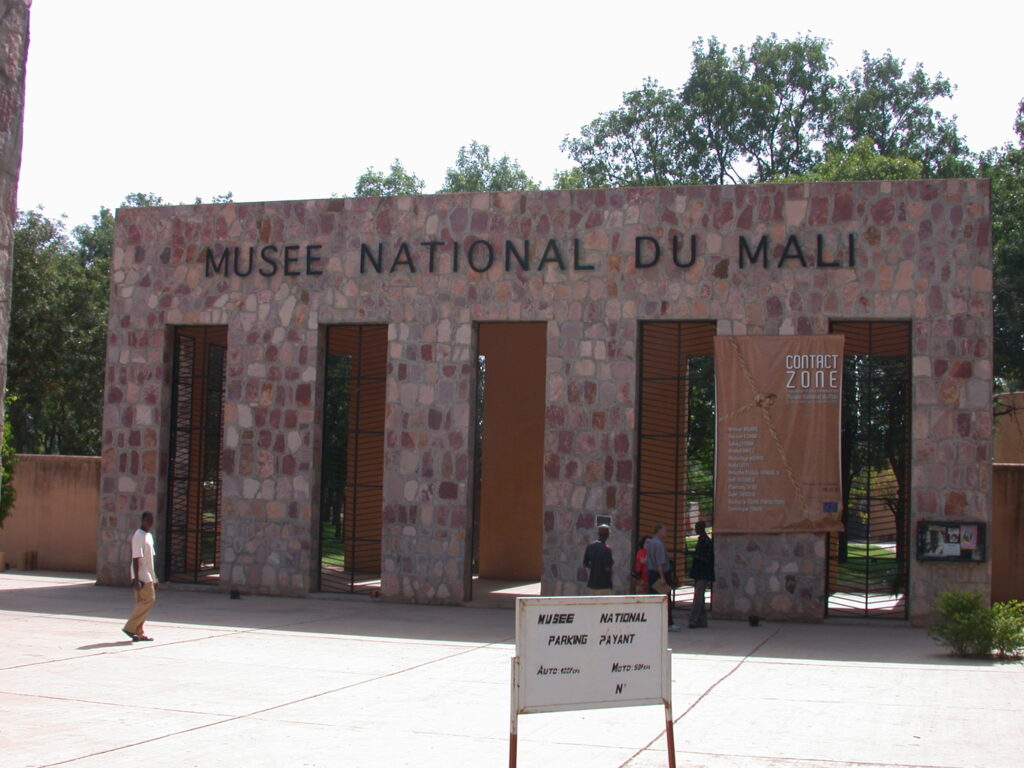
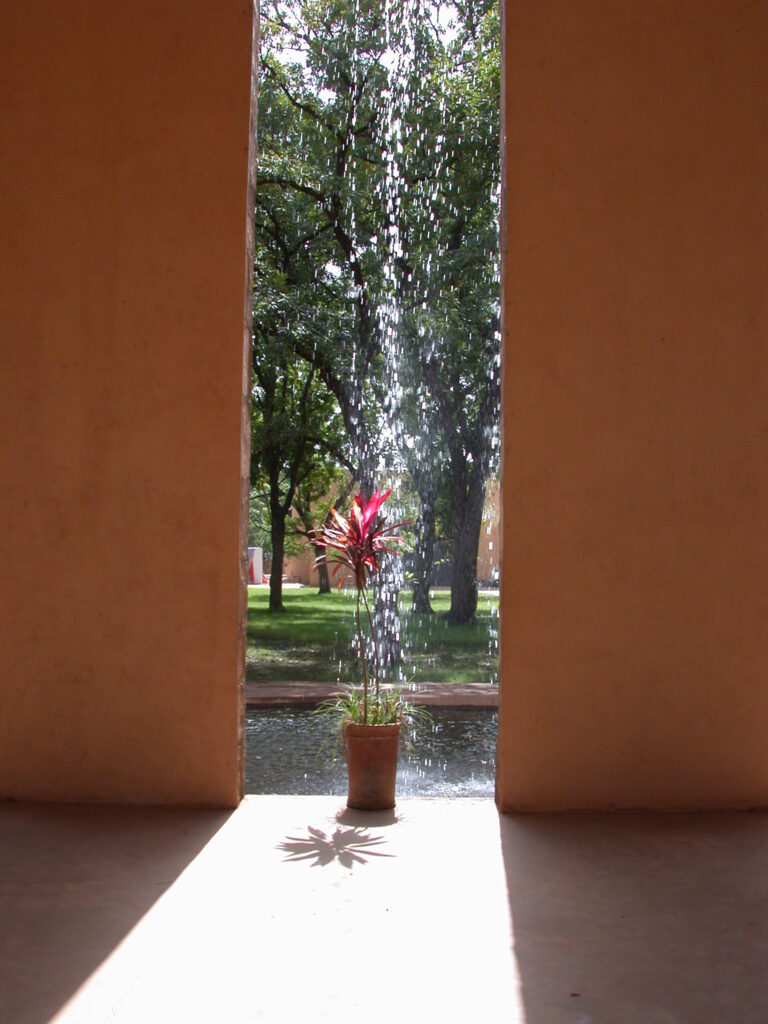
The museum is excellent. I first wandered past an outdoor sculpture of a typical Malian bus into an art exhibition where hundreds of children scrambled around the museum hall interacting with some amazing art.

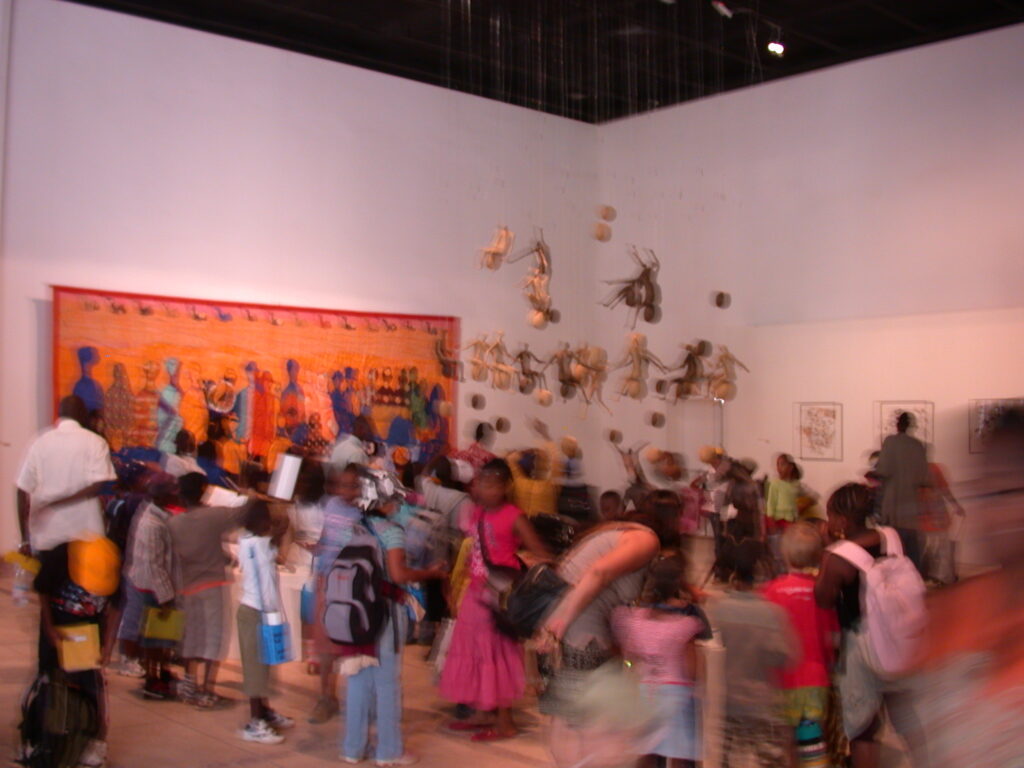
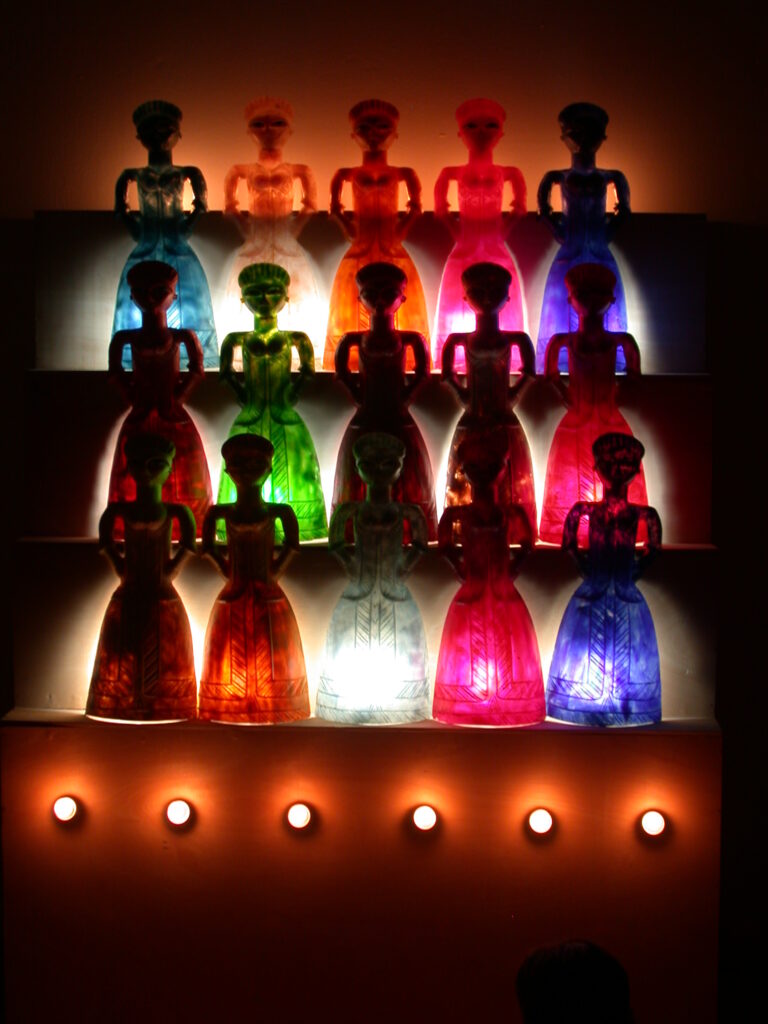
The other main hall of the museum contains its permanent exhibits about Ancient Mali, Ritual Art, and Textiles. I took lots of notes because pictures weren’t permitted, and I bought a few postcards documenting the key artifacts in the museum, such as the Dogon “Thinker” statue with snakes all over his body, the almost East-Indian-style statue of a reclining man, and the ancient textiles with interesting patterns from the people inhabiting the Dogon region before the Dogon themselves arrived.
In the garden on the way out of the museum, I saw a variety of models of famous buildings in Mali, particularly of the mosque at Jenne-Jeno, and the waterfall at the entrance once again.
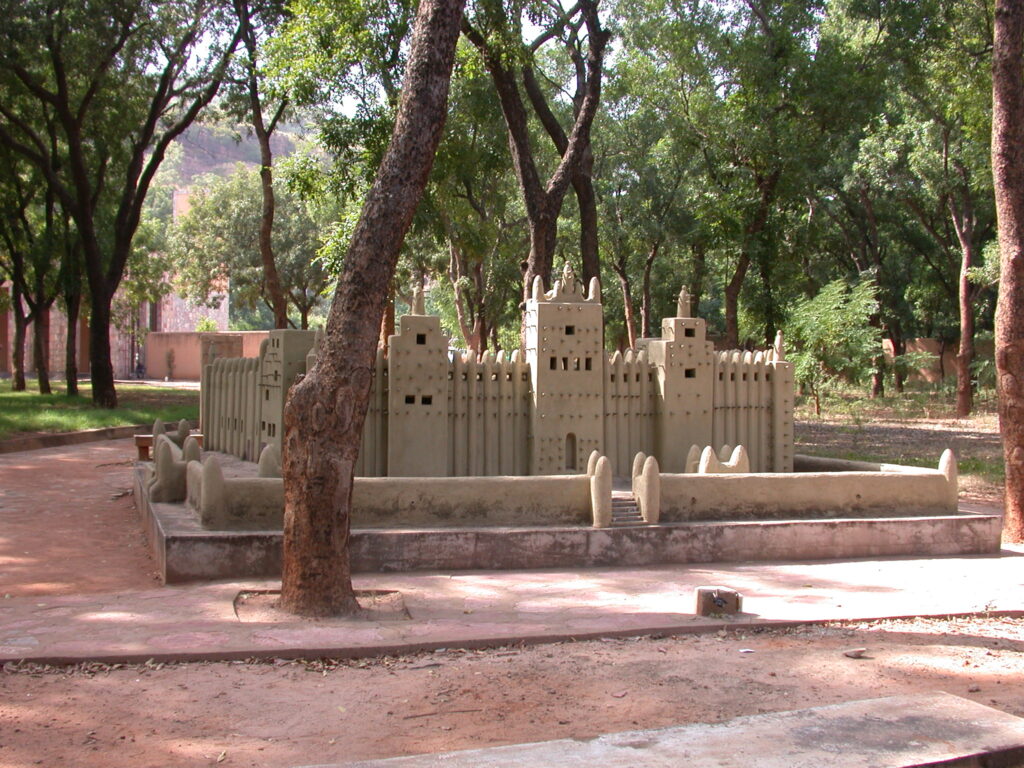
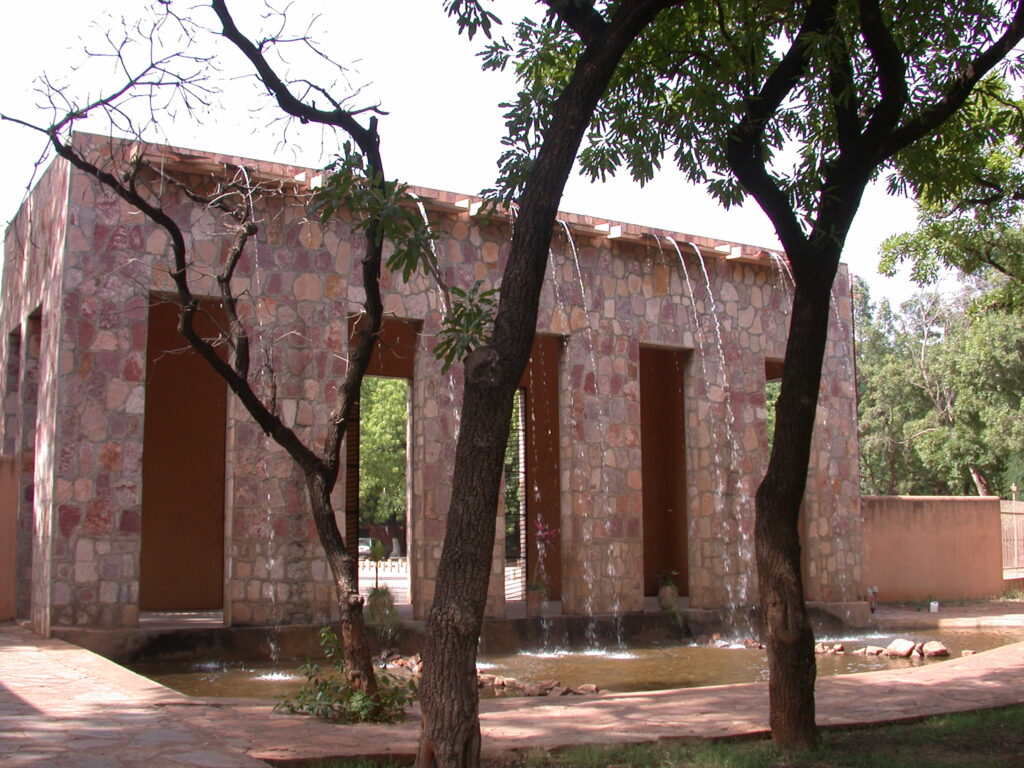
Notes on National Museuem in Bamako:
A great museum! (in three parts)
ANCIENT MALI–
Tellem — in rock escarpments of Bandiagara, people who lived from 11th to 16th century, Dogon people found them there, textiles are among oldest found in Africa, also leather, wood, and metal artifacts found in sepulchral grottos
Before the Tellem came the “Toloy phase”, 3rd to 2nd century BCE, grotto A with round elevated constructions, architectural elements also appear in Ireli and Bongo villages
Neck rests found in grotto of Sanga, 11th to 14th century CE, made from wood or iron, some with geometrical patterns
Leather boot with geometrical designs, Tellem, Songa
Cache sexe, leather hem with twisted strands, presumably to cover genitals
Belt of leather strands, approximately ten
Bracelets, metal, some thin, some thick, some with twisted pattern
Pottery, “vannerie”, and “Fécipient (Récipient) en calabasse”, Tellem, Sanga, 11th – 15th centuries CE
Grotto P
Round and oval constructions from 11th – 12th centuries CE
Rectangular constructions from 13th – 14th centuries CE for living quarters
Grenier? = granaries(?)
Bankoni, Bamako, statuette, clay, long face, head tilted back, tongue sticking out a little, Szumowski found in 1954 in a pseudo-tumulus
Sirakorola, Koulikoro region, ceramic bottles with spherical containers and cylindrical necks, found in vast necropolis, the necks sometimes chopped off before the ceramics baked, heads on the necks include: cow, ram, cock, bird, lamb, and human
==> Oueyanko, west of Bamako, phalliform object, Szumowski found in 1954 in a pseudo-tumulus (see drawing in journal)
Fakola, Bougouni region, tortoise in clay, and a quadruped in clay
Probably southern Mali: two clay statuettes, region with relatively more rainfall, dense vegetation and forests sites such as Magnambougou, Kouroukorokalé, Fanfannyégéné rock opening
Tongo Maaré Diabel (the dune “au jujubier”) is one of the oldest cities studied in Mali, three kilometers north of Douentza between Bandiagara and “les falaises” (escarpments) of Dyoudé, 5th – 13th century CE, agricultural society, “le mil” = millet(?), rarised cows, sheep, and goats, also had blacksmiths, commercial relations with Berbers to the north — found semiprecious stones “coralines” and “amazonites”, transaharan commerce starting in 10th century when glass appears, many pottery vases discovered there, a horse rider statue in clay from 9th – 11th century
Natamatao site: iron tools, including disk, “poinçon”, “enclumes”, axe, “marteau” associated with “scories”, clay statues of quadrupeds, probably ram and lamb
Waganzana site near Thial, same period as Natamatao, statue fragments
Natamatao is six kilometers from village of Thial (Tenenkou (or Tenemkou?) circle), human figure with horse head, also found skeletons painted in red ocher, so probably funerary site, clay head statue probably from top of a vase, very different style
==> Djenné, probably 13th – 15th century CE, statuette of a man seated with head rested on arms crossed on knees, covered with serpents
Natamatao, Thial:
Vase decorated with serpents (similar to Dejenné but different due to large opening)
Stops to put in tops of vases
Vase with geometric pattern
Djenné Djéno, 13th century, three kilometers from Djenné
==> Stylized clay statue of male figure wearing necklaces, serpent ring on right bicep, two bracelets above right elbow, one on right wrist, two bracelets on left wrist, possibly dagger in sheath on left bicep, headless, wearing “cache sexe”
Bust
Djenné Djéno founded in 3rd century BCE, surrounded by a wall two kilometers in length, population 10,000 – 26,000, long-distance commerce, objects of Roman origin found, copper and flass beads, socles de fer, fusables -> tissage, abandoned by 14th century, probably due to domination of Islam in the region
Statuettes with “boutons” from 13th century
Mopti
Clay mask
Globular vases decorated with serpents, clay
“Pied de lit”, clay, origin Kami
Djenné Djéno
LARGE vase “caréné”, 600-900 CE, clay
LARGE funerary jar, clay, tradition of either putting bones of entire body in jar, pierced the
bottom on purpose to signify funerary function
Gao, Sané necropolis, funerary stela from 12th – 13th century, written in Andalusian/Maghrebian style characters
Tomboutou (Timbuktu)
Vases, clay
Bottles, clay
Hematite “polissoir” to test quality of gold
(Imported?) glass fragments
Alabaster window
Small vase (inkwell?)
Copper (coins?)
Iron knife blade
Variety of beads, including wooden ones
Bed supports
Sites at Kawinza, Mouyassan, and Toubal (near Sumpi)
Rice and millet cultures
Fishery
RITUAL ART–
Dogon statue of primordial couple — origin myth of eight lineages, wood
Dogon statue of Nommo, master of water, life, speech, and fecundity, arms attached to something over head, wood, first being created by Amma
Dogon statue of four first ancestors, wood
Gwandusu, Bamanan, Baninko circle of Dioila, statue of maternity or paternity, wood
Ntomo (Notomokun) masks, Banaman, Ségou region, Ntomo society for children aka Cèbilenkè (Beledugu) and Bilakorojo (Birgo and Baninko), number of horns indicates sex of mask: male (3 or 6), female (4 or 8 ), androgynous (2, 5, 7, or 9), often covered with cowries and red seeds or berries, “la discretion” of the mouth -> control over speech, important in those societies
Bamanan, Diolila region, hyena masks, wood
Do mask, Boo, wood
Cimiero — for dancing (Ciwarakun), Bamanan
Senoufo statue slave, “Tabitière des captifs”, hunched over, carrying bowl with cover that has monkey on top, wood
Sogow or marionette, Ségou villages, Kamelan ton associations organize Sogo Bwo animal dances also theater for educational purposes, festival of masks and marionettes (FESMAMA)
Dogon — toguna pillar, wood, feminine figure accentuating breasts and vagina without facial detail
Peul — gold pendant (dola)
Cimier for dance, Ngosonkun, Bamanam, Koulikoro region, wood
Boo, feminine statue Hanbé, for protection of village, wood, long tall, looks like mohawk on head
Senoufo, feminine figure (debele) associated with male figure, ritual scarification, primordial couple
Dogon, Satimé mask, wood and paint
Dogon, multistory house mask, very tall, painted wood
Dogon, Kanaga mask, arms above head, two hands pointed up above two hands pointed down, painted wood and fiber
Dama mourning ritual
Kono (konokun) mask, Bamanan, wood, horns, blood sacrifice of animals
Senoufo, Janus mask (Kponiougo), wood
TEXTILES–
carbon dating from 10th – 13th centuries CE
Peul migrations introduced textile fabrication around 9th century CE
Tilbi — cotton or silk garment signifying high status, Djenné or Tombouctou (Timbuktu)
Bogolan technique for dying cloth
Hunter shirts, example with mirrors, beads, fabric strands, amulets to protect from nyama, always brown and yellow, never indigo (representing nature, not village)
Protective garment “sigi (or sugi?) doki” with text and geometrical designs and amulets wrapped and sewn on
The Peul griots are also wool fabric artisans, they are called Maabo, plural Maabuube, their wives are traditionally potters. The Maabuube are similar in importance to the blacksmiths of the Manding called Numu, whose wives are also potters, located in “boucle du Niger”, Niger River flood plain, wool provides protection against cold and mosquitoes
Peul arkille fabric, often very long, used for nuptial bed, symbol of marriage
Kaasa — another garment formerly worth more than a sheep
Tellem textiles, Sangha, Bandiagara, ancient people who arrived in Dogon country at the weakening of the Ghana empire in the 11th century (Dogons arrived in 14th century)
Tellem textiles included important symbolism, not just pretty designs, no method of fabrication found with other artifacts, so may be imported (?), tunics from 10th – 12th centuries, lots of indigo color, écharpe = ?, strange red designs (see drawing in journal), striped indigo-white cap cotton, another with vertical triangular stripes to the top center
